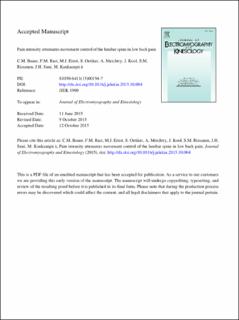Please use this identifier to cite or link to this item:
https://doi.org/10.21256/zhaw-2707Full metadata record
| DC Field | Value | Language |
|---|---|---|
| dc.contributor.author | Bauer, Christoph | - |
| dc.contributor.author | Rast, Fabian | - |
| dc.contributor.author | Ernst, Markus | - |
| dc.contributor.author | Oetiker, Sarah | - |
| dc.contributor.author | Meichtry, André | - |
| dc.contributor.author | Kool, Jan | - |
| dc.contributor.author | Rissanen, Saara M. | - |
| dc.contributor.author | Suni, Jaana H. | - |
| dc.contributor.author | Kankaanpää, Markku | - |
| dc.date.accessioned | 2018-08-08T08:18:01Z | - |
| dc.date.available | 2018-08-08T08:18:01Z | - |
| dc.date.issued | 2015 | - |
| dc.identifier.issn | 1050-6411 | de_CH |
| dc.identifier.issn | 1873-5711 | de_CH |
| dc.identifier.uri | https://digitalcollection.zhaw.ch/handle/11475/8894 | - |
| dc.description.abstract | Pain intensity attenuates muscular activity, proprioception, and tactile acuity, with consequent changes of joint kinematics. People suffering from low back pain (LBP) frequently show movement control impairments of the lumbar spine in sagittal plane. This cross-sectional, observational study investigated if the intensity of LBP attenuates lumbar movement control. The hypothesis was that lumbar movement control becomes more limited with increased pain intensity. Methods: The effect of LBP intensity, measured with a numeric rating scale (NRS), on lumbar movement control was tested using three movement control tests. The lumbar range of motion (ROM), the ratio of lumbar and hip ROM as indicators of direction specific movement control, and the recurrence and determinism of repetitive lumbar movement patterns were assessed in ninety-four persons suffering from LBP of different intensity and measured with an inertial measurement unit system. Generalized linear models were fitted for each outcome. Results: Lumbar ROM (+0.03°, p = 0.24) and ratio of lumbar and hip ROM (0.01, p = 0.84) were unaffected by LBP intensity. Each one point increase on the NRS resulted in a decrease of recurrence and determinism of lumbar movement patterns (-3.11 to −0.06, p ⩽ 0.05). Discussion: Our results indicate changes in movement control in people suffering from LBP. Whether decreased recurrence and determinism of lumbar movement patterns are intensifiers of LBP intensity or a consequence thereof should be addressed in a future prospective study. | de_CH |
| dc.language.iso | en | de_CH |
| dc.publisher | Elsevier | de_CH |
| dc.relation.ispartof | Journal of Electromyography and Kinesiology | de_CH |
| dc.rights | http://creativecommons.org/licenses/by-nc-nd/4.0/ | de_CH |
| dc.subject | Biomechanical phenomena | de_CH |
| dc.subject | Movement disorders | de_CH |
| dc.subject | Recurrence quantification analysis | de_CH |
| dc.subject | Adult | de_CH |
| dc.subject | Aged | de_CH |
| dc.subject | Biomechanical Phenomena | de_CH |
| dc.subject | Female | de_CH |
| dc.subject | Humans | de_CH |
| dc.subject | Low Back Pain | de_CH |
| dc.subject | Lumbar Vertebrae | de_CH |
| dc.subject | Male | de_CH |
| dc.subject | Middle Aged | de_CH |
| dc.subject | Muscle, Skeletal | de_CH |
| dc.subject | Range of Motion, Articular | de_CH |
| dc.subject | Movement | de_CH |
| dc.subject | Postural Balance | de_CH |
| dc.subject.ddc | 617.5: Orthopädische Chirurgie | de_CH |
| dc.title | Pain intensity attenuates movement control of the lumbar spine in low back pain | de_CH |
| dc.type | Beitrag in wissenschaftlicher Zeitschrift | de_CH |
| dcterms.type | Text | de_CH |
| zhaw.departement | Gesundheit | de_CH |
| dc.identifier.doi | 10.21256/zhaw-2707 | - |
| dc.identifier.doi | 10.1016/j.jelekin.2015.10.004 | de_CH |
| dc.identifier.pmid | 26524940 | de_CH |
| zhaw.funding.eu | No | de_CH |
| zhaw.issue | 6 | de_CH |
| zhaw.originated.zhaw | Yes | de_CH |
| zhaw.pages.end | 927 | de_CH |
| zhaw.pages.start | 919 | de_CH |
| zhaw.publication.status | acceptedVersion | de_CH |
| zhaw.volume | 25 | de_CH |
| zhaw.publication.review | Peer review (Publikation) | de_CH |
| zhaw.webfeed | Angewandte Gerontologie | de_CH |
| zhaw.funding.zhaw | „Valedo Movement Lab“: Das portable Bewegungslabor misst Bewegungs-Qualität bei unteren Rückenschmerzen | de_CH |
| Appears in collections: | Publikationen Gesundheit | |
Files in This Item:
| File | Description | Size | Format | |
|---|---|---|---|---|
| 2015_Bauer_Pain_intensity_attenuates_movement_control.pdf | 1.43 MB | Adobe PDF |  View/Open |
Show simple item record
Bauer, C., Rast, F., Ernst, M., Oetiker, S., Meichtry, A., Kool, J., Rissanen, S. M., Suni, J. H., & Kankaanpää, M. (2015). Pain intensity attenuates movement control of the lumbar spine in low back pain. Journal of Electromyography and Kinesiology, 25(6), 919–927. https://doi.org/10.21256/zhaw-2707
Bauer, C. et al. (2015) ‘Pain intensity attenuates movement control of the lumbar spine in low back pain’, Journal of Electromyography and Kinesiology, 25(6), pp. 919–927. Available at: https://doi.org/10.21256/zhaw-2707.
C. Bauer et al., “Pain intensity attenuates movement control of the lumbar spine in low back pain,” Journal of Electromyography and Kinesiology, vol. 25, no. 6, pp. 919–927, 2015, doi: 10.21256/zhaw-2707.
BAUER, Christoph, Fabian RAST, Markus ERNST, Sarah OETIKER, André MEICHTRY, Jan KOOL, Saara M. RISSANEN, Jaana H. SUNI und Markku KANKAANPÄÄ, 2015. Pain intensity attenuates movement control of the lumbar spine in low back pain. Journal of Electromyography and Kinesiology. 2015. Bd. 25, Nr. 6, S. 919–927. DOI 10.21256/zhaw-2707
Bauer, Christoph, Fabian Rast, Markus Ernst, Sarah Oetiker, André Meichtry, Jan Kool, Saara M. Rissanen, Jaana H. Suni, and Markku Kankaanpää. 2015. “Pain Intensity Attenuates Movement Control of the Lumbar Spine in Low Back Pain.” Journal of Electromyography and Kinesiology 25 (6): 919–27. https://doi.org/10.21256/zhaw-2707.
Bauer, Christoph, et al. “Pain Intensity Attenuates Movement Control of the Lumbar Spine in Low Back Pain.” Journal of Electromyography and Kinesiology, vol. 25, no. 6, 2015, pp. 919–27, https://doi.org/10.21256/zhaw-2707.
Items in DSpace are protected by copyright, with all rights reserved, unless otherwise indicated.